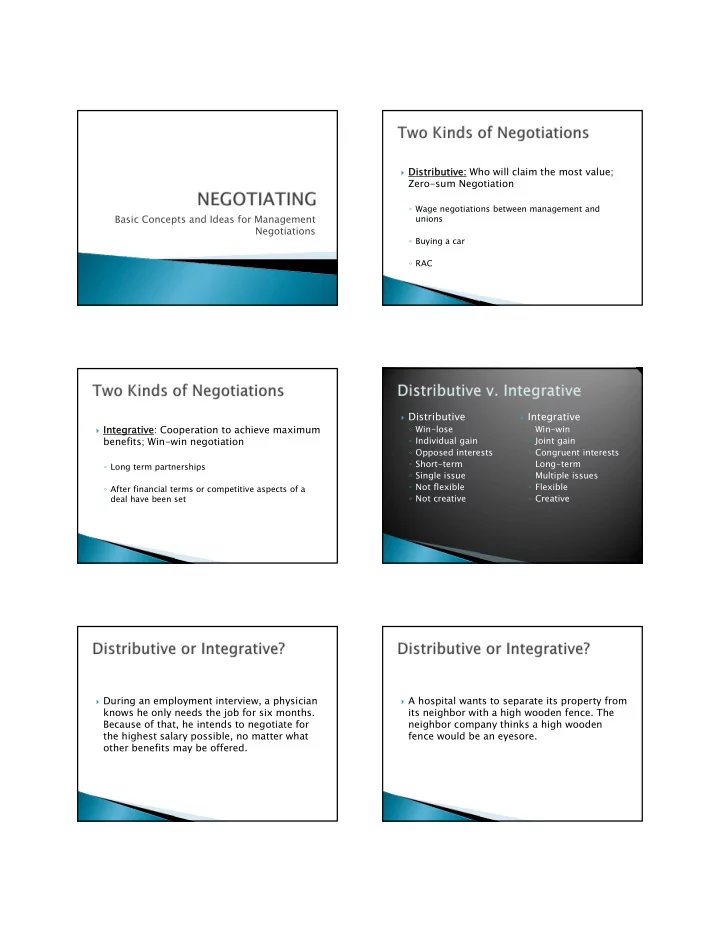

Dist Distribu butive: Who will claim the most value; Zero-sum Negotiation ◦ Wage negotiations between management and Basic Concepts and Ideas for Management unions Negotiations ◦ Buying a car ◦ RAC Distributive Integrative Inte Integr grative: Cooperation to achieve maximum ◦ Win-lose ◦ Win-win benefits; Win-win negotiation ◦ Individual gain ◦ Joint gain ◦ Opposed interests ◦ Congruent interests ◦ Short-term ◦ Long-term ◦ Long term partnerships ◦ Single issue ◦ Multiple issues ◦ Not flexible ◦ Flexible ◦ After financial terms or competitive aspects of a deal have been set ◦ Not creative ◦ Creative During an employment interview, a physician A hospital wants to separate its property from knows he only needs the job for six months. its neighbor with a high wooden fence. The Because of that, he intends to negotiate for neighbor company thinks a high wooden the highest salary possible, no matter what fence would be an eyesore. other benefits may be offered.
Implemented over time in different phases More than two party's Context allows parties to negotiate based on Natural coalitions: Shared interests follow-through and continuing communication Single-issue coalitions: Unite to support or block a single issue One hospital system buying other hospitals A hospital buying group practices Your party’s interest and coalition interests Familiarity with other party’s communication and negotiation style If weak, consider forming a coalition with others Build trust Breaking other party coalition: successful Monitor other party to insure follow-up when if is a single issue coalition Walk away from disconcerting negotiations “A negotiated solution is only advantageous Preferred course of action in the absence of a when a better option in not available.” deal Best Alternative to a Negotiated Settlement Knowing alternative actions absent of a deal (BATNA) Reservation or walk away price Point of saying “no” to an unfavorable deal Zone of Possible Agreement (ZOPA) Know BATNA before negotiating Value Creation Through Trades
Accept the deal only if the A is lower than the Walk-away point highest monthly fee you’re willing to pay. Derived from BANTA, but not the same Meet with another office equipment supplier to see what their leasing arrangements cost. May be similar if it is only about money Buy used office equipment instead of leasing new equipment. When preparing to negotiate with a commercial landlord Range in which a deal can be made over a lease for office space, you consider that you are currently paying $20 per square foot. This number is your BA BATN TNA. Reservation price determines ZOPA’s You also take into account the fact that the new location would be closer to clients and provide a more attractive ◦ A buyer has set a reservation price of $275,000 for workspace, thus you'd be willing to pay $30 per square the purchase of a commercial warehouse and would foot. That's your reserv reservat atio ion price price. like to pay as little as possible. The seller has set a reservation price of $250,000 and would like to If more than $30 per square foot is required, you'll walk obtain as much as possible. The ZOPA, away and attempt to lease space in a different building. During the negotiation the landlord insists on $35 per ◦ Therefore, is the range between $250,000 and square foot and won't accept anything lower, thereby $275,000. indicating that his reserv reservation price price is $35 per square foot. Negotiating parties can improve positions by trading the values at their disposal Seller Buyer Integrated negotiations •$250K $275K Each party gets something in return for ------ ZOPA------- something it values much less Book collectors; professional athletes
Determine satisfactory outcomes first 4. Improve your BATNA 1. Good for you, good for them ◦ Determines “say no” point Motivations, concerns, needs of party's ◦ Improve BATNA before and during talks Identify opportunities to create value 5. Assess who has authority 2. Common ground, compromise, trades ◦ Decision maker; authority of negotiator ◦ Establish at the beginning of negotiations Identify you BATNA and reservation price 3. 6. Study the other side Yours and theirs, if possible Recognize when to hold ‘em, when to fold ‘em ◦ Personality, style, background, culture, goals values; personal connections, research 7. Prepare for flexibility in the process At the beginning: ◦ Be patient, not always as planned ◦ New people, unexpected developments ◦ Positive tone, openness to other sides concerns 8. Gather objective criteria for fairness ◦ Review agenda ◦ Continuing relationship with other side ◦ Explain what is favorable/unfavorable ◦ Discuss expectations 9. Alter the process in your favor ◦ Offer information about interests and concerns, but be cautious ◦ Hidden or set agendas; make logistical changes Disclose little, learn much Inquire about the other sides interests, needs, concerns Establish an anchor: start first offer in the right place Provide significant information about your Make cautious concessionary moves circumstances; your interests, issues constraints. Set time lines Look for differences to create value Offer multiple proposals and/or packages Signal Interest in closing the deal Take your time
Die-hard bargainers Lack of trust ◦ Know their game ◦ Emphasize the need for integrity ◦ Be guarded in the information you disclose ◦ Request documentation ◦ Suggest alternative options if they do not share ◦ Add contingencies; penalties for noncompliance or information incentives for early performance ◦ Be willing to walk away Differences in gender and culture Irrational escalation ◦ Study and realize differences ◦ Consider assumptions each party brought to the table Partisan perceptions Difficulties in communication Unreasonable expectations ◦ Ask for a break ◦ Raise the misunderstood issue for clarification Overconfidence Unchecked emotions
Recommend
More recommend